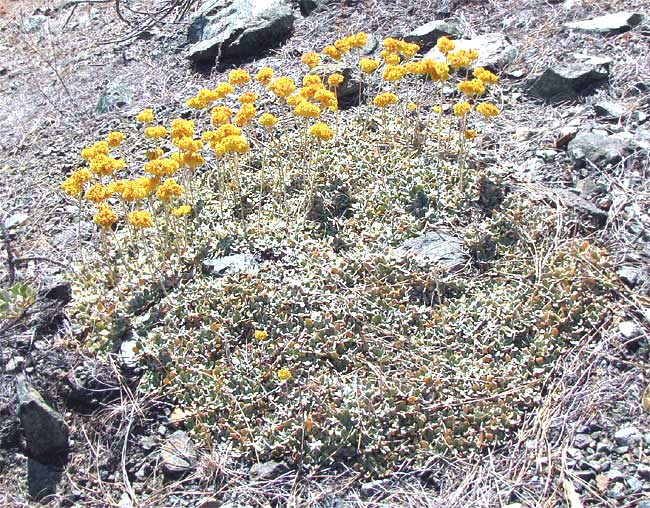Excerpts from Jim Conrad's
Naturalist Newsletter

from the the August 30, 2009 Newsletter, issued from the Siskiyou Mountains west of Grants Pass, Oregon:
WILD BUCKWHEATS
Since my arrival here in early spring I've seen many wild buckwheat species flower, fruit and subside -- many species of the genus Eriogonum of the Buckwheat Family, the Polygonaceae. Probably the best-known Buckwheat Family member to most North Americans is the smartweed. Seeing a lot of wild buckwheat species can be exciting here because, as they say on a US Forest Service page about endemic wildflowers "In the Klamath-Siskiyou region ... the genera with the most endemic taxa are Eriogonum
(7), Phacelia (4), Minuartia (3), Erythronium (3), Erigeron
(3), Epilobium (3)."
So, if you're looking for rare plants in this area, pay special attention to wild buckwheats, the genus Eriogonum.
The reason I haven't yet profiled a wild buckwheat is that I've been waiting for one I could identify with certainty. But that's hard. California's Jepson Manual lists 115 species just for there. In contrast, Weakley's Flora of the Carolinas and surrounding area lists only three species; Wild buckwheats are mainly Western plants. To get a feeling for them you can browse pictures of California's wild buckwheats at http://calphotos.berkeley.edu/browse_imgs/plant_sci_190.html.
During my backpacking hike this week at about 3500 feet on a steep, rocky serpentine slope a particularly pretty Eriogonum showed up, its golden flower clusters glowing in intense sunlight, and I decided that the time had come to try for an ID. You can see the plants above.

Above I've removed flowers on the near side of a dense flower cluster so you can see how the bugle-shaped blossoms arise on slender pedicels in clusters subtended by bracts (modified leaves) almost the way composite flowers do it, and that these clusters are themselves clustered in groups subtended by bracts. The flowers when younger probably were pure yellow but now they're fading a bit and developing a rosy tinge.
I'm about 90% sure that this is the Sulphur Flower, ERIOGONUM UMBELLATUM, native to western North America from California to Colorado and central Canada. Often it grows abundantly and in many habitats. In fact, it's one of the most variable of all flowering-plant species, the Flora of North America recognizing 41 varieties, which is amazing. In form the species can manifest itself as anything from a clumping perennial herb five inches tall to a sprawling shrub six feet high and wide.
Native Americans used the plant medicinally. The Kawaiisu used mashed flowers as a salve for gonorrheal sores; the Owens Valley Piute employed the plant for colds and stomachaches; The Cheyenne used a mixture of powdered stems and flowers to halt lengthy menses. On and on the uses go, varying from plant variety to variety, and from human culture to culture.
The hard, three-cornered little fruits can be ground and used as flour, though each plant produces so few of them that you'd have to spend a lot of time picking them just to make a biscuit.